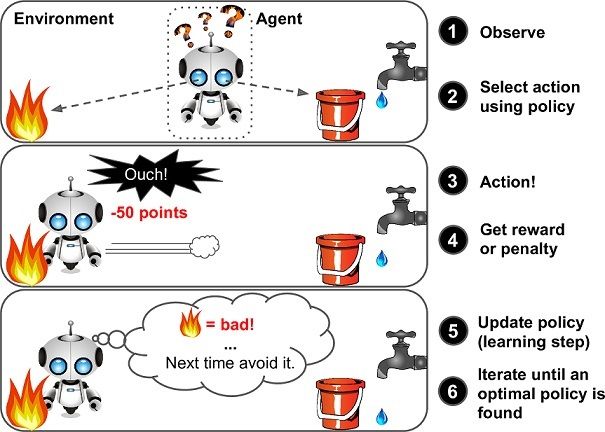

A Complete Guide to Boost Your Business with Reinforcement Learning






Among other things, Elon Musk wants to create self-training robots that will put an end to housework. Machine learning experts at OpenAI have demonstrated that deep reinforcement through observation and exploration could prove decisive in making a lot of tasks easier. It is driving many a robot to do the job of a human, primarily through observation and exploration.
It branches out from Artificial Intelligence and is classified as a Machine Learning type. Leveraging reinforcement learning, software agents and machines are made to ascertain the ideal behavior in a specific context with the aim of maximizing its performance.

The reinforcement learning model prophesies interaction between two elements – Environment and the learning agent. The learning agent leverages two mechanisms namely exploration and exploitation. When the learning agent acts on trial and error, it is termed as exploration, and when it acts based on the knowledge gained from the environment, it is referred to as exploitation. The environment rewards the agent for correct actions, which is the reinforcement signal. Leveraging the rewards obtained, the agent improves its environment knowledge to select the next action.
Now, artificial agents are being created to perform the tasks as a human. These agents have made their presence felt in businesses, and the use of agents driven by reinforcement learning is cut across industries.
A peep into a factory gives the inside information of tasks getting carried out here. Take, for instance, the task of picking a device from one box and putting it in a container. Robots are now training themselves to do this job with great speed and precision. Fanuc, a Japanese company, takes pride in the industrial robot that is clever enough to train itself to do this job.
This robot uses deep reinforcement learning to get trained to learn and perform a new task. While it picks an object, it also captures the video footage of this process. Whether it succeeds or fails, it memorizes the object and gains knowledge as part of the deep learning model controlling the actions of the robot.
Optimizing space utilization is a challenge that drives warehouse managers to seek best solutions. The high volumes of inventory, fluctuating demands for inventories and slow replenishing rates of inventory are hurdles to cross before using warehouse space in the best possible way. Reinforcement learning algorithms can be built to reduce transit time for stocking as well as retrieving products in the warehouse for optimizing space utilization and warehouse operations.
Dynamic pricing is a well-suited strategy to adjust prices depending on supply and demand to maximize revenue from products. Techniques like Q-learning can be leveraged to provide solutions addressing dynamic pricing problems. Reinforcement learning algorithms serve businesses to optimize pricing during interactions with customers.
A manufacturer wants to deliver products for customers with a fleet of trucks ready to serve customer demands. With the aim to make split deliveries and realize savings in the process, the manufacturer opts for Split Delivery Vehicle Routing Problem. The prime objective of the manufacturer is to reduce total fleet cost while meeting all demands of the customers.
For this manufacturer, agent approach that hinges on reinforcement learning comes good to meet desired results. By introducing the multi-agents system, agents are made to communicate and cooperate with one another, learn through reinforcement learning. Q-learning is then leveraged to serve appropriate customers with just one vehicle. The manufacturer reaps benefits by improving execution time and by reducing the number of trucks used for meeting the demands of customers.
For retailers and e-commerce merchants, it has grown into an absolute imperative to tailor communications and promotions fitting customer purchasing habits – Personalization is at the core of promoting relevant shopping experiences to capture customer loyalty. Reinforcement learning algorithms are proving their worth by allowing e-commerce merchants to learn and analyze customer behaviors and tailor products and services to suit customer interests.
Pit.ai is at the forefront leveraging reinforcement learning for evaluating trading strategies. It is turning out to be a robust tool for training systems to optimize financial objectives. John Moody and Matthew Saffell have demonstrated how reinforcement learning can be used for optimizing trading systems built for single trading security or trading portfolios.
hiHedge is the proof of how reinforcement learning is leveraged in trading scenarios. It uses AI trader which is involved in continuous learning for generating trading strategies for users and helping them realize their investment goals.
Companies seeking to improve their AI capabilities often turn to specialized AI development services for reinforcement training expertise.
A dynamic treatment regime (DTR) is a subject of medical research setting rules for finding effective treatments for patients. Diseases like cancer demand treatments for a long period where drugs and treatment levels are administered over a long period. Reinforcement learning addresses this DTR problem where RI algorithms help in processing clinical data to come up with a treatment strategy, using various clinical indicators collected from patients as inputs.
As humankind is searching for ways to make the machine perform the tasks of human, technology has emerged the driving force making this possible. Where there is a big gap between the idea and reality, reinforcement learning has given hope by driving robots and machines to perform tasks that were unimaginable at one time. This is just the beginning. It is emerging as an innovative technology that can drive business value.

